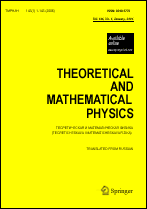|
|
Teoreticheskaya i Matematicheskaya Fizika, 1989, Volume 80, Number 2, Pages 173–191
(Mi tmf5128)
|
 |
|
 |
This article is cited in 4 scientific papers (total in 4 papers)
Quantization of the gravitational field in the neighborhood of the Schwarzschild solution in the relativistic theory of gravitation
K. A. Sveshnikov, P. K. Silaev, O. A. Khrustalev
Abstract:
Quantization of the relativistic theory of gravity [2] is performed by the method of group variables [1] in the neighbourhood of the spherically symmetric (Schwarzschild) solution for empty space. It is shown that the presence in the relativistic theory of gravity of the complete group of spatial-temporal symmetries makes it possible to remove unphysical degrees of freedom with the help of the group variables. The quantum hamiltonian is diagonalized in the quadratic approximation in the perturbing field and the formulation of boundary conditions in singular points of the background metric is investigated. Boundary conditions in the limiting singular point $r=m$ imply splitting of the space of states into the subspace of states localized in the region $r>m$ and the subspace of states localized in the region $r<m$. States defined in the whole range of the radial variable are also constructed. Their wave functions are “continuous” (in the sense of the flux continuity) at the point $r=m$.
Received: 16.05.1989
Citation:
K. A. Sveshnikov, P. K. Silaev, O. A. Khrustalev, “Quantization of the gravitational field in the neighborhood of the Schwarzschild solution in the relativistic theory of gravitation”, TMF, 80:2 (1989), 173–191; Theoret. and Math. Phys., 80:2 (1989), 790–804
Linking options:
https://www.mathnet.ru/eng/tmf5128 https://www.mathnet.ru/eng/tmf/v80/i2/p173
|


| Statistics & downloads: |
| Abstract page: | 571 | | Full-text PDF : | 173 | | References: | 84 | | First page: | 1 |
|




 Contact us:
Contact us: Terms of Use
Terms of Use
 Registration to the website
Registration to the website Logotypes
Logotypes









 Citation in format
Citation in format 
